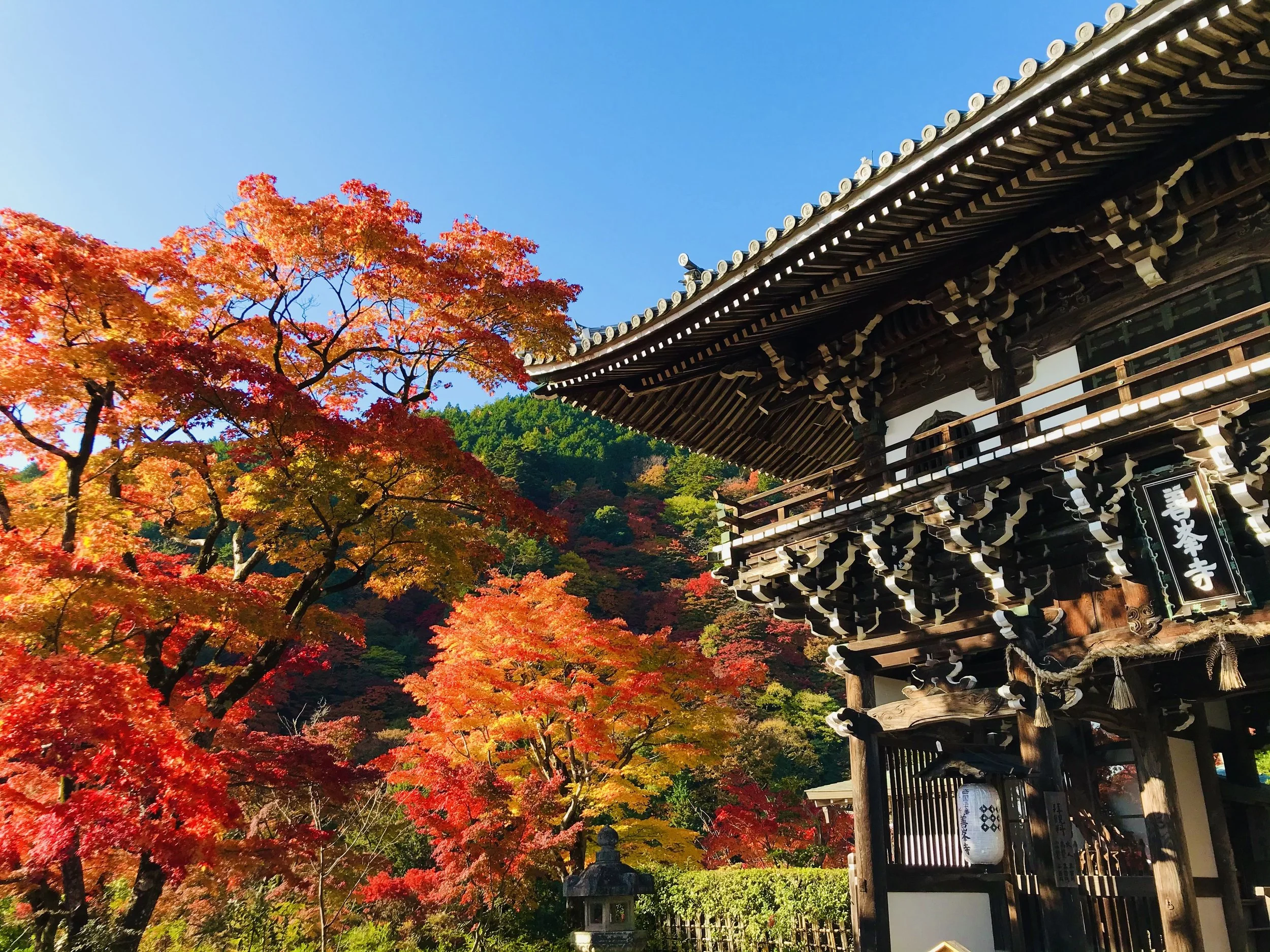Autumn Leaves in Kyoto
Beauty, Belief, and Timeless Tradition
Brilliant autumn leaves frame the grand gate of Yoshimine Temple, where mountain air and vivid colors create a moment of serene beauty.
Each autumn, Kyoto becomes a stage where nature and culture intertwine in one of Japan’s most celebrated seasonal spectacles—the turning of the leaves. From late October through early December, fiery shades of crimson, gold, and amber transform temple gardens, mountain paths, and riverside walks into landscapes that feel almost otherworldly.
The Japanese word for autumn leaf viewing is momijigari, literally “hunting for red leaves.” This tradition dates back over a thousand years, when aristocrats of the Heian period (794–1185) composed poetry and painted scenes celebrating the changing seasons.
In Buddhism, which profoundly shaped Kyoto’s cultural life, autumn leaves symbolize impermanence (mujō 無常), reminding us that all things are transient. Just as blossoms fall in spring, leaves blaze brightly before fading away—an image of beauty that is fleeting but deeply moving.
Shinto, Japan’s indigenous faith, also plays a role in the reverence for autumn. Many shrines are nestled within ancient forests, where nature itself is considered sacred. The changing leaves are seen as an expression of the divine, inviting visitors to reflect on their connection with the natural world. This intertwining of faith and cultural heritage adds depth to the seasonal spectacle, transforming a simple walk through the trees into a moment of contemplation.
Kyoto’s autumn leaves are more than a seasonal highlight; they are part of a living tradition that weaves together art, religion, and everyday life. For centuries, poets, monks, and travelers have paused to admire the fleeting colors of the season, which embody both joy and a reminder of life’s impermanence. Today, visitors from around the world come to share in this moment, joining a tradition that is both timeless and ever renewed.
Whether from the quiet of a Zen garden, the bustle of a riverside district, or the heights of a temple veranda, Kyoto’s autumn leaves are not only breathtakingly beautiful but also a chance to reflect, connect, and be moved. To witness the season in Kyoto is to experience Japan at its most radiant—a city where nature and spirit come together in every falling leaf.
Kiyomizu Temple Night-time Special Opening & Illumination
Recommended Lesser-Known Autumn Colors in Kyoto
Tofuku-ji Temple
Located in southeastern Kyoto, Tofuku-ji Temple’s vast temple grounds are covered with thousands of trees, best admired from the Tsutenkyo Bridge, which overlooks a deep valley aflame with color. The combination of Zen architecture and natural scenery makes Tofuku-ji Temple a place where spiritual reflection and visual splendor meet.
9:00–16:00; ¥500; JR Keihan Tofuku-ji Sta. and a 10-min walk; tofukuji.jp
Bishamondo Temple
Nestled in the Yamashina district, Bishamondo is one of Kyoto’s hidden treasures for autumn colors. The long stone stairway leading to the temple is famously lined with maple trees, forming a brilliant red-and-gold tunnel in late November. Within the temple grounds, visitors can enjoy a stroll garden with a reflective pond that captures the vibrant leaves, as well as views of the elegant shoin-style architecture framed by autumn hues.
9:00–17:00; JR or Subway Tozai Line, Yamashina Sta. and a 20-min walk; bishamondo.or.jp
Yoshimine Temple
Perched on the western hills of Kyoto, Yoshimine Temple offers sweeping views of the city along with brilliant autumn colors. Its expansive temple grounds, laid out on a slope, are home to around 1,000 maple trees that peak in late November. The vibrant foliage frames historical halls, pagodas, and gardens, while the approach paths provide a layered panorama of red leaves against the city skyline below.
8:30–17:00; ¥500; Take a bus from Mukōmachi Sta. or Hankyu Higashi-Muko Sta.; yoshiminedera.com
Otagi Nenbutsu-ji Temple
Hidden away in the northern reaches of Arashiyama, Otagi Nenbutsu-ji Temple is best known for its 1,200 whimsical stone rakan statues—each with a unique expression. In autumn, the vibrant foliage of maples and ginkgo trees accentuates the moss-covered statues and temple halls. The combination of playful stone figures and fiery leaves creates a distinctive, almost otherworldly charm.
8:00–16:15; Closed Wed.; ¥300; 2-5 Saga Toriimoto, Arashiyama; otagiji.com




